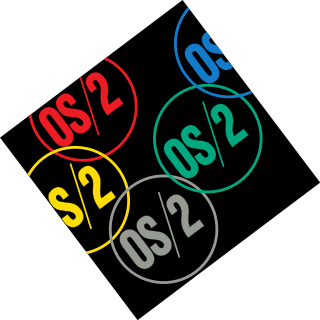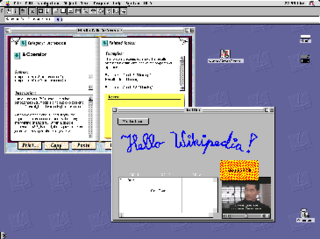Related Research Articles
A fourth-generation programming language (4GL) is a high-level computer programming language that belongs to a class of languages envisioned as an advancement upon third-generation programming languages (3GL). Each of the programming language generations aims to provide a higher level of abstraction of the internal computer hardware details, making the language more programmer-friendly, powerful, and versatile. While the definition of 4GL has changed over time, it can be typified by operating more with large collections of information at once rather than focusing on just bits and bytes. Languages claimed to be 4GL may include support for database management, report generation, mathematical optimization, GUI development, or web development. Some researchers state that 4GLs are a subset of domain-specific languages.
HyperCard is a software application and development kit for Apple Macintosh and Apple IIGS computers. It is among the first successful hypermedia systems predating the World Wide Web.

OS/2 is a series of computer operating systems, initially created by Microsoft and IBM under the leadership of IBM software designer Ed Iacobucci. As a result of a feud between the two companies over how to position OS/2 relative to Microsoft's new Windows 3.1 operating environment, the two companies severed the relationship in 1992 and OS/2 development fell to IBM exclusively. The name stands for "Operating System/2", because it was introduced as part of the same generation change release as IBM's "Personal System/2 (PS/2)" line of second-generation personal computers. The first version of OS/2 was released in December 1987 and newer versions were released until December 2001.

GNUstep is a free software implementation of the Cocoa Objective-C frameworks, widget toolkit, and application development tools for Unix-like operating systems and Microsoft Windows. It is part of the GNU Project.
HyperTalk is a discontinued high-level, procedural programming language created in 1987 by Dan Winkler and used in conjunction with Apple Computer's HyperCard hypermedia program by Bill Atkinson. Because the main target audience of HyperTalk was beginning programmers, HyperTalk programmers were usually called "authors" and the process of writing programs was known as "scripting". HyperTalk scripts resembled written English and used a logical structure similar to that of the Pascal programming language.
In computing, cross-platform software is computer software that is designed to work in several computing platforms. Some cross-platform software requires a separate build for each platform, but some can be directly run on any platform without special preparation, being written in an interpreted language or compiled to portable bytecode for which the interpreters or run-time packages are common or standard components of all supported platforms.
The resource fork is a fork or section of a file on Apple's classic Mac OS operating system, which was also carried over to the modern macOS for compatibility, used to store structured data along with the unstructured data stored within the data fork.
In computing, Open Database Connectivity (ODBC) is a standard application programming interface (API) for accessing database management systems (DBMS). The designers of ODBC aimed to make it independent of database systems and operating systems. An application written using ODBC can be ported to other platforms, both on the client and server side, with few changes to the data access code.
Claris International Inc., formerly FileMaker Inc., is a computer software development company formed as a subsidiary company of Apple Computer in 1987. It was given the source code and copyrights to several programs that were owned by Apple, notably MacWrite and MacPaint, in order to separate Apple's application software activities from its hardware and operating systems activities.

A virtual file system (VFS) or virtual filesystem switch is an abstract layer on top of a more concrete file system. The purpose of a VFS is to allow client applications to access different types of concrete file systems in a uniform way. A VFS can, for example, be used to access local and network storage devices transparently without the client application noticing the difference. It can be used to bridge the differences in Windows, classic Mac OS/macOS and Unix filesystems, so that applications can access files on local file systems of those types without having to know what type of file system they are accessing.
Windows Presentation Foundation (WPF) is a free and open-source graphical subsystem originally developed by Microsoft for rendering user interfaces in Windows-based applications. WPF, previously known as "Avalon", was initially released as part of .NET Framework 3.0 in 2006. WPF uses DirectX and attempts to provide a consistent programming model for building applications. It separates the user interface from business logic, and resembles similar XML-oriented object models, such as those implemented in XUL and SVG.

Oracle Media Objects, formerly Oracle Card, was a software development tool for developing multi-media applications, with functionality and appearance similar to Apple Inc.'s HyperCard.
Data Access Language for the Macintosh, or simply DAL, was a SQL-like language and application programming interface released by Apple Computer in 1990 to provide unified client/server access to database management systems. It was known for poor performance and high costs, something Apple did little to address over its short lifetime, before it was sold off in 1994. DAL is used as the native SQL dialect of the PrimeBase SQL server, as well as the now-defunct Butler SQL.
The Data Access Manager (DAM) was a database access API for the classic Mac OS, introduced in 1991 as an extension to System 7. Similar in concept to ODBC, DAM saw little use and was eventually dropped in the late 1990s. Only a handful of products ever used it, although it was used for some extremely impressive demoware in the early 1990s. More modern versions of the classic Mac OS, and macOS, use ODBC for this role instead.
EMC NetWorker is an enterprise-level data protection software product from Dell EMC that unifies and automates backup to tape, disk-based, and flash-based storage media across physical and virtual environments for granular and disaster recovery.
Omnis Studio is a rapid application development (RAD) tool that allows programmers and application developers to create enterprise, web, and mobile applications for Windows, Linux, and macOS personal computers and servers across all business sectors.
An Internet operating system, or Internet OS, is any type of operating system designed to run all of its applications and services through an Internet client, generally a web browser. The advantages of such an OS would be that it would run on a thin client, allowing cheaper, more easily manageable computer systems; it would require all applications to be designed on cross-platform, open standards; and would not tie a user's applications, documents, and preferences to a single computer, but rather place them in the Internet cloud. The Internet OS has also been promoted as the perfect type of platform for software as a service.

Mono is a free and open-source .NET Framework-compatible software framework. Originally by Ximian, it was later acquired by Novell, and is now being led by Xamarin, a subsidiary of Microsoft and the .NET Foundation. Mono can be run on many software systems.
Docker is a set of platform as a service (PaaS) products that use OS-level virtualization to deliver software in packages called containers. The service has both free and premium tiers. The software that hosts the containers is called Docker Engine. It was first released in 2013 and is developed by Docker, Inc.
References
- ↑ Don Crabb, "Plus Extends and Improves Hypercard Interface", InfoWorld, 6 November 1989, pp. S9-S10
- ↑ Scott Mace, "ObjectPlus comes through with beefed-up WinPlus", InfoWorld, 28 November 1994, p. 29
- ↑ Yvonne Lee, "Oracle Card 1.1 slated for Windows and Pens", InfoWorld, 27 April 1992, p. 8
- ↑ Kim Nash, "Oracle to build interactive TV systems", ComputerWorld, 17 January 1994, p. 8